|
Introduction
The fact that the
architecture of modernism represents
an important part of the cultural
heritage of the Kingdom of
Yugoslavia and, in particular,
socialist Yugoslavia, seems to be a
peculiar truism. It is also known
that the emergence and rapid
development of the architecture of
modernism were linked to two
groundbreaking years in the history
of both states – 1929, when the
Kingdom of Serbs, Croats and
Slovenes changed its name, structure
and ideological direction, after the
imposition of the so-called 6
January Dictatorship and collapse of
parliamentarism, and 1948, when the
Cominform Resolution was adopted and
the relations with the Soviet Union
were temporarily broken off. During
the fourth decade of the 20th
century, just like during the sixth,
seventh and eighth decade, something
that is usually considered as
“architectural modernism” or “modern
architecture” became the dominant
architectural idiom in Yugoslavia.
In each synchronic cross-section it
was both the part of the repertoire
of the official state representation
and the inviolable poetical credo of
the generations of Yugoslav
architects. However, the intrinsic
link between the Yugoslav
architecture of modernism and its
raison d'être in its own historical
context or, in other words, the
relation between poetics and
politics remained in the shadow of
great historiographic narratives
about the local variations of global
modernism and the autonomy of
architecture as part of the modern
project.
If we understand
the term “modernism” as an
emancipatory shift towards the
transformation of society and
progressivist movement towards its
imaginary contours on the “horizon
of the expected”, then the role of
the architecture of modernism in the
history of the first and second
Yugoslavia must inevitably be
redirected. Architecture must be
relocated from the sphere of
autonomous theory and practice, that
is, the part of culture that is
usually understood as the sphere
enclosed by specificity and
peculiarity, and defined not only by
poetical boundaries, but also by
ideological and political ones. In
fact, we understand architecture not
as an autonomous and self-sufficient
reality, but as the constituent part
of an imaginative world of ideology
within which different
“architectural phenomena” (ranging
from individual elements, buildings,
through formal and stylistic
characteristics, to the broader
concept of architecture as an
epistemological project and
discipline) represent semantical
structures which are crucial for the
creation of an idea of collective
belonging and identity.
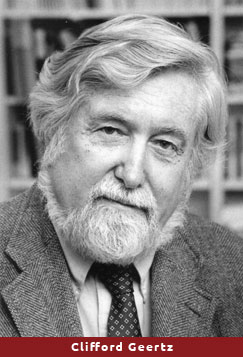 At the same time,
one must bear in mind that modernism
is a specific ideological construct
of historiography and criticism or,
in other words, the projection of
the basically different and
seemingly universal value systems
onto cultural artifacts and
processes, whereby “culture” must be
understood in the anthropological
sense of the word or, for example,
from the usual perspective if
interpretive theories of culture,
like the one advanced in the works
by Clifford Geertz. Thus, we will
also view the architecture of
modernism as part of a symbolic
universe in which it objectivized
and formally shaped social reality,
while at the same time shaping
itself relative to it and vice
versa. In this connection, one must
always bear in mind the difference
between the interconnected notions
of “culture” and “society” based on
Talcott Parsons and Edward Shils’s
classical model, defining culture
(and architecture as its integral
part) as a semantic system or
symbolic world, while society is
determined by a network of social
relations whose meaning is given
just by cultural forms. Thus,
architecture also cannot be
understood outside the social
context from which it originates as
part of the modern project, but the
ways in which its relationship, as
an integral part of culture and
society, is perceived and
established, are different. On the
one side, according to the most
vital interpretive tradition of
modern art — from Clement Greenberg,
through Giulio Carlo Argan, to
Filiberto Menna – the art of
modernism is understood as a
fundamental part of the
progressivist paradigm of societal
development, that is, a specific
pedagogical instrument and
methodological model for society; in
addition, it forms part of the
modern project as the process of
building critical answers to the
questions posed by social reality.
On the other side, however,
according to contemporary scientific
interpretations – which view culture
as an ideological system that shapes
the values defining society and
building collective identities – the
architecture of modernism emerges as
one of the ideological orders or
symbolic practices. In any case, the
link between modernist architecture
and social context is crucial for
understanding or interpreting its
cultural specificities and social
roles, the task that imposes itself
upon every historian dealing with
this historical phenomenon. At the same time,
one must bear in mind that modernism
is a specific ideological construct
of historiography and criticism or,
in other words, the projection of
the basically different and
seemingly universal value systems
onto cultural artifacts and
processes, whereby “culture” must be
understood in the anthropological
sense of the word or, for example,
from the usual perspective if
interpretive theories of culture,
like the one advanced in the works
by Clifford Geertz. Thus, we will
also view the architecture of
modernism as part of a symbolic
universe in which it objectivized
and formally shaped social reality,
while at the same time shaping
itself relative to it and vice
versa. In this connection, one must
always bear in mind the difference
between the interconnected notions
of “culture” and “society” based on
Talcott Parsons and Edward Shils’s
classical model, defining culture
(and architecture as its integral
part) as a semantic system or
symbolic world, while society is
determined by a network of social
relations whose meaning is given
just by cultural forms. Thus,
architecture also cannot be
understood outside the social
context from which it originates as
part of the modern project, but the
ways in which its relationship, as
an integral part of culture and
society, is perceived and
established, are different. On the
one side, according to the most
vital interpretive tradition of
modern art — from Clement Greenberg,
through Giulio Carlo Argan, to
Filiberto Menna – the art of
modernism is understood as a
fundamental part of the
progressivist paradigm of societal
development, that is, a specific
pedagogical instrument and
methodological model for society; in
addition, it forms part of the
modern project as the process of
building critical answers to the
questions posed by social reality.
On the other side, however,
according to contemporary scientific
interpretations – which view culture
as an ideological system that shapes
the values defining society and
building collective identities – the
architecture of modernism emerges as
one of the ideological orders or
symbolic practices. In any case, the
link between modernist architecture
and social context is crucial for
understanding or interpreting its
cultural specificities and social
roles, the task that imposes itself
upon every historian dealing with
this historical phenomenon.
The mentioned contemplations form a
conceptual framework within which
the overview of the architecture of
modernism in the first and second
Yugoslavia will be made. This
overview does not intend to be
all-embracing and present a
comprehensive picture, or point to
all manifestations and achievements
of this phenomenon. Focus will be
laid on the consideration of the
cultural specificities of the
architecture of modernism in the
Yugoslav context and the related
ideological roles. This is also a
modest contribution towards getting
over the fear of historicism that
prevails in the significant part of
architectural historiography in
Serbia, although it alone is derived
from the culture of the modern
project. Should architectural
modernism be separated from what it
designated in its context, that is,
from its own semiotic sphere, we
would face the challenge of the
random or nonrandom creation of a
peculiar forgery. Just as history is
not an autonomous field of the
interpretation of the past, but
represents an effort toward its
careful conceptualization, the
history of architectural modernism
in Yugoslavia cannot be reduced to
the issues of the formal, stylistic
or social aspects of architecture.
Instead, it must explore its
meanings from a broader perspective,
involving the creation of the value
system and identity model.
Therefore, the common view that the
architecture of modernism advocated
a distinctive value system based on
progressivism, evolutionism and
other universal premises, and
generated a number of poetic
strategies, formal patterns and
stylistic characteristics,
constructing architecture as an
autonomous cultural object, must be
put in parentheses.
Understandably,
our approach has its limitations
and, like any other interpretation,
is the result of a conscious
compromise between subordination to
the supratextual plane of theory and
the historization of “modern
architecture”, which is constantly
hindered by the discourse of its
autonomy. Such an approach to the
architecture of modernism can help
us enter the conceptual (and
political) world in which those who
found themselves within the Yugoslav
borders in the period 1929-1980
lived. We will view architectural
modernism as a symbolic framework
for something that the political
regimes in the first and second
Yugoslavia pitted against social
reality — or, in other words, as the
ideological patterns deriving their
power and effectiveness from real
political life and not from the
protected fields of architectural
theory and history.
***
Toward the end of
the third decade of the 20th
century, the modernist breakthrough
into Yugoslavia’s architectural
culture was violent and tempestuous.
As early as the mid-1929, “modern
architecture” became omnipresent in
public space. Indeed, in almost
every interpretation of the
phenomenon of modernism it was
emphasized that the abrupt emergence
of modern architecture in a
conservative environment, like that
of the Yugoslav capital, was made
possible by a series of
circumstances, whereby a decisive
role was played by the royal
dictatorship imposed by King
Aleksandar I Karadjordjević. It was
emphasized that the “6 January
regime” contributed to the
legalization of a break with the
past, and that in the early 1930s
new architecture, as an opposite to
“old historical styles”, was widely
accepted in the whole country.
Indeed, modernism could respond
symbolically to the political
demands for national unification and
depict the Yugoslav nation, culture
and state without “tribal blindness”
or “spiritual chaos” — everything
that caused the sharp change of the
political course in the early 1929
which, after the tragic events in
the Yugoslav parliament in the
previous year’s summer, occurred
during the time interval between the
imposition of the royal dictatorship
and promulgation of the so-called
octroyed constitution in early
September 1931.
Understandably,
the simultaneity of an abrupt
ideological change and the emergence
of architectural modernism was not
the fruit of chance. The allegedly
ahistorical character and universal
language of “modern architecture”
functioned as the cultural
confirmation of the new course and
had a significant role and great
power, primarily because they
represented a positive projection of
the demands for national
unification, ethnic unity, break
with the past and erasure of
“tribal”, political and cultural
traditions. In contrast to other
stylistic and formal configurations
on the architectural scene — and, in
particular, different “national” and
regional idioms — modernism was not
burdened by the existing national or
ethnic conceptions, so that it
became the most convenient means for
the representation of an ideal
environment for the new Yugoslav man
and idealized image of the new
Yugoslav culture.
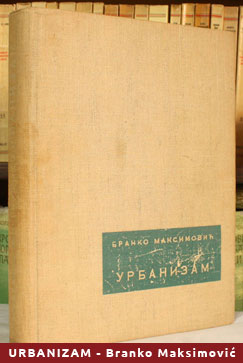 When in the
mid-1930s Belgrade’s architect
Branko Maksimović clearly pointed
out that “modern architecture
completely rejects all those narrow
national borders and thus
contributes to some extent to
rapprochement among peoples”, that
was only one of the cultural values
determined by Belgrade’s architects
and political elites as being the
basic characteristic of modern
architecture. The new idiom was
playing an increasingly greater role
in the rhetoric of the then
reactualized integral Yugoslavism
and was also gaining ground in
public space. Truly, Belgrade’s
public instantly accepted the
language of architectural modernism
due to a number of other reasons. In
a broader context, architectural
modernism also represented a
peculiar simulation of progress and,
like historical-style architecture,
civilizational foundation.
Nevertheless, its key role lied in
the fact that it helped cultivate
Yugoslav national authenticity
through the politically promoted
thesis that modern architecture
would erase cultural and ethnic
boundaries, and that it was based on
“authentic” vernacular architecture.
In fact, “international” modernism
experienced its “nationalization”,
while modern architecture became
part of the construction of
primordial Yugoslav identity that
could be interpreted and used in
diverse political registers. When in the
mid-1930s Belgrade’s architect
Branko Maksimović clearly pointed
out that “modern architecture
completely rejects all those narrow
national borders and thus
contributes to some extent to
rapprochement among peoples”, that
was only one of the cultural values
determined by Belgrade’s architects
and political elites as being the
basic characteristic of modern
architecture. The new idiom was
playing an increasingly greater role
in the rhetoric of the then
reactualized integral Yugoslavism
and was also gaining ground in
public space. Truly, Belgrade’s
public instantly accepted the
language of architectural modernism
due to a number of other reasons. In
a broader context, architectural
modernism also represented a
peculiar simulation of progress and,
like historical-style architecture,
civilizational foundation.
Nevertheless, its key role lied in
the fact that it helped cultivate
Yugoslav national authenticity
through the politically promoted
thesis that modern architecture
would erase cultural and ethnic
boundaries, and that it was based on
“authentic” vernacular architecture.
In fact, “international” modernism
experienced its “nationalization”,
while modern architecture became
part of the construction of
primordial Yugoslav identity that
could be interpreted and used in
diverse political registers.
It only seems
paradoxical that architectural
modernism could be mobilized for the
construction of different national
and cultural identities in different
contexts. In Yugoslavia during the
1930s the same shaping idiom could
be interpreted in the key of
Yugoslav, Serbian or Croatian
national identity. At the same time,
it could also connote leftist
ideology – just like in the case of
the Soviet Union, “Red Vienna”,
public architecture of the socialist
municipalities in Germany during the
1930s, or Jewish cultural identity —
not only in the interpretive
tradition of National Socialism, but
also in the light of the then usual
identification of modern
architecture and Jewishness, in
particular. In the context of this
semiotic fluidity of modernism, it
is especially ironic that Croatian
nationalism, one of the centrifugal
ideologies relative to Yugoslavism
during the 1930s, fixed the
architecture of modernism before the
mirror which would reflect
everything conceived by its
protagonists, rallied primarily
around the group called “Zemlja”
(Earth). The practice of Croatian
nationalists to interpret
architectural modernism as the
formula of an unadulterated demotic,
Croatian national identity was
congtruent with the actions towards
the Yugoslavization of modern
architecture, which were carried out
in Belgrade.
At the same time,
architectural modernism was the
instrumental formula of the new
Yugoslav regime, placing the state
and its nation under the aegis of
the Western civilization, anchored
in the idea of progress. In the
positivist-evolutionist concept of
culture, modernism was identified as
a more perfect cultural formation
relative to the past, which
corresponded to the ideological
requirements of the dictatorship of
King Aleksandar I Karadjordjević. In
a similar way it also corresponded
to the requirements of the
secularization and cultural
levelling of Turkish national
identity at the time of the Kemal
Ataturk regime, which was at its
zenith. In general, one must bear in
mind that, during the late 1920s and
1930s, linking modernist
architecture to new political
ideologies or social, economic and
political reforms was a universal
phenomenon – extending from the
Soviet Union and Fascist regime in
Italy, as well as the revolutionary
and totalitarian regimes in Central
Europe (Hungary, Czechoslovakia,
Romania and Poland), to Kemalism in
Turkey, or Zionism at the time Tel
Aviv was built. In all mentioned
cases, the discourse of
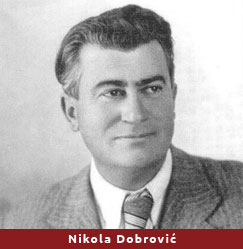 architectural modernism legalized
these new regimes as “progressive”
and “reform-oriented”. Just from
that perspective it is necessary to
perceive the role of architectural
modernism in the Kingdom of
Yugoslavia, which is evidenced by
the fact that the crucial
architectural representations backed
by the regime were based on the
recognizable modernist vocabulary —
ranging from official national
pavilions at the world expositions
(Barcelona, 1929; Milan, 1931;
Paris, 1937) to, for example, the
architectural competition for the
construction of Terazije Terrace in
Belgrade at which the seemingly
quite “modernist” design of Nikola
Dobrović won the first prize (1929). architectural modernism legalized
these new regimes as “progressive”
and “reform-oriented”. Just from
that perspective it is necessary to
perceive the role of architectural
modernism in the Kingdom of
Yugoslavia, which is evidenced by
the fact that the crucial
architectural representations backed
by the regime were based on the
recognizable modernist vocabulary —
ranging from official national
pavilions at the world expositions
(Barcelona, 1929; Milan, 1931;
Paris, 1937) to, for example, the
architectural competition for the
construction of Terazije Terrace in
Belgrade at which the seemingly
quite “modernist” design of Nikola
Dobrović won the first prize (1929).
In Yugoslavia’s
specific political context at the
end of the third and at the
beginning of the fourth decade of
the 20th century, modernist
architecture advocated a broad
spectrum of cultural values with a
distinctly political dimension. Just
thanks to this broad spectrum,
architecture became one of the most
important forms of representing
Yugoslavism. The accompanying danger
of the national, social or general
political disintegration of Yugoslav
society, echoes of the
intensification of the global
economic crisis and series of
foreign political factors,
contributed that modernism became an
inexhaustible treasury for the
presentation of the desirable
attributes of the Yugoslav nation,
and the system of its cultural
values and cultural policy, so that
it won over almost the entire public
space in the Yugoslav capital within
a short time. It is important to
note that already in the early
1930s, thanks to architectural
modernism, something being
increasingly viewed as
“international modernism” was
adopted as being consistent with the
idea of Yugoslav national culture,
which was shaping the original
national identity that transcended
the ethnic boundaries of Serbdom,
Croatdom and Slovenedom – for two
crucial reasons. The first and less
important reason was the
international character of modern
architecture and its conscious
neglect of everything local or
ahistorical. The second reason
seemingly distorted the ahistorical
dimension of modernism by pointing
to deep structural relations between
the “modern building method” and,
understandably, ideologically
acceptable vernacular architectural
heritage. Namely, in the discourse
of integral Yugoslavism vernacular
architecture was already designated
as the representation of the
original primordial tradition that
allegedly faithfully reflected the
idea of the unadulterated Yugoslav
spirit. During the fourth decade,
pro-Yugoslav architects,
intellectuals and political elites
advanced the theses about the
conceptual, structural and ethical
correspondence between vernacular
and contemporary architecture, thus
interpreting architectural modernism
as the contemporary reincarnation of
the “Yugoslav” national tradition.
At the time when the shift away from
ethnic particularisms represented a
tour de force of the overall
cultural policy, the construction of
“authentic” identity was a much more
complex venture than the
interpretation of modernism as
simply building “in a contemporary
way”. One of the crucial roles in
this ambitious venture was assigned
to the discourses of modernist
architecture. The allegedly
original, national and – according
to the established ideological
analogy – genuine Yugoslav
architecture emerged, as it was
held, in the “spirit of the national
genius” much before the beginning of
the separate tribal histories of
Serbs, Croats and Slovenes. However,
the new architecture of modernism
was nothing else but the reinvention
of the existing national tradition.
It used new materials and forms, but
its inner essence remained the same.
What was common to modern and
national architecture from the
perspective of the culture of
Yugoslav nationalism included their
common ideals, primarily a direct
relationship between man, nature and
material culture. Thus, the
architecture of modernism became a
direct and authentic link with the
primordial Yugoslav past. Thus, a
direct relation was established
between the authentic Yugoslav
nation — which was believed to exist
from time immemorial but, due to
historical circumstances, was split
into three tribes — and the
contemporary national community of
Yugoslavs. At the same time, by
linking the principles and elements
of modern architecture to local,
profane architecture the idea was
developed that, thanks to its
authentic spirit, Yugoslav national
culture already belonged to the
contemporary Western civilization.
***
Just this shift
towards the West was one of the
important aspects in the cultural
and political construction of
Yugoslavia’s “specific road” to
communism when, after the invention
of the Yugoslav “socialist
democracy” and self-management
system in the early 1960s, the
architecture of modernism reassumed
a crucial role in the legitimization
of the “new situation”. Like in the
post-1929 period, when integral
Yugoslavism needed a material,
tangible form, the specificity of
Yugoslav socialism was legitimized
by new, modernist architecture. In
both cases, the resolute shift away
from historicism and the pastiche of
historical and “national” styles,
meant symbolic distancing from one
ideological direction, one value
system and one identity concept, and
transition to quite a different
ideological identity domain.
As is well known,
the specificities of the second
Yugoslavia were reflected in its
position relative to the Cold War
division of the world, authenticity
and originality of Yugoslav
socialism, and the policy of the
proclaimed specific road as an
autonomous heading toward a
classless communist society.
Contrary to what was usually
understood as the rigid bureaucratic
centralism and etatism of the Soviet
Union and Eastern Bloc countries, on
the one side, and Western political
liberalism, on the other side, the
Yugoslav elites tried to find,
establish and preserve the complex
ideological construction of
“Yugoslavia at the crossroads”.
Paving Yugoslavia’s specific road to
communism was marked by its role
relative to the global political,
social and economic order, the role
that was instrumentalized by the
policy of non-alignment and active
peaceful co-existence on the
international plane, and the
principles of all-embracing
decentralization, workers’
self-management and social ownership
concept at home. The characteristics
of Yugoslavia’s specificity pointed
to the country’s mediatory role and
something presented by its
intellectual elites as an
avant-garde in the development of
the consciousness of humanity in its
heading towards the new, liberated
man and humanized society. By
bridging the gap between the
socialist system and democracy,
Yugoslavia’s socialist democracy
also had to bridge a triple gap
between the ever-changing reality of
everyday life, fixed image of the
surmounted past and proclaimed
vision of the future. Such a
transitional situation, as the
crucial feature of the ideology that
legitimized Yugoslavia’s political
system and process of its continuous
transformation, was basically
associated with the belief in the
inevitable withering away of the
state — the fundamental principle
derived from the interpretation of
original Marxism — that is, the
transformation of the state into the
post-state. During the period
between 1952, when the principle of
self-management was introduced, and
the death of Josip Broz Tito, which
symbolically marked a new phase in
the history of socialist Yugoslavia,
transformation, reforms and
instability established themselves
as the structure of long duration,
which characterized all constituent
elements of the federal state.
In this context,
architecture played a fundamental
role. Its place in building the
ideology of Yugoslavia’s socialist
democracy rested above all upon the
projection of the personal freedom
of each individual, as the basis for
the emancipation of the entire
society and its segments, as well as
upon the idea about the autonomy of
architecture. In the Yugoslav
context, the architecture of
modernism acquired a peculiar
teleological position, so that it
virtually and literally presented
the picture of the promised future
toward which the entire society was
heading. As both a symbolic and
actual construction of the
ideological system, architecture
advocated the idea of progress,
freedom, transition and continuous
evolution, thus legitimizing a broad
modernization process. This implied
the interpretation of the new system
of management and “deetatization” as
the transition of the state
functions to free citizens and,
according to Aleksandar Ranković,
the strengthening of their
confidence in the “value of their
personal freedom and human rights,
and the role of individual citizen
in the management of social life”.
At the pragmatic level of
architectural culture, this policy
was based on the Western model of
identifying modernism in arts and
architecture with liberalism, and
shifting away from communism (as
contrasted to the usual associations
of modernism and leftism before the
Second World War), which was
developed during the Cold War
period.
The peculiar
teleological position of modernist
architecture in socialist Yugoslavia
can best be illustrated by numerous
architectural and urban planning
competitions and general urban
plans, which not only outlined the
desired “future situation”, but also
played a strong educational role in
Yugoslavia’s architectural and
political culture. Although most of
these plans were never realized,
their place in public space
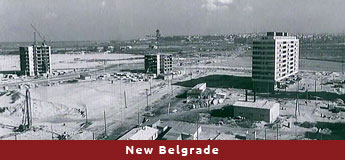 significantly determined and
confirmed the contents on which the
ideology of a transitional phase was
based. However, probably the most
significant project of this
transitional and teleological regime
was the planning and building of New
Belgrade —both the symbol of the new
Yugoslavia and the model for its
building. As an “ideological centre
of brotherhood and unity” – as this
major project was first called by
the Yugoslav political elites — New
Belgrade was systematically included
in the discourse of transition as
part of a complex ideological
narrative implying the introduction
of a number of differences —
differences relative to the recent
past that established a normative
and value framework for the
realization of the projected future.
Since the first plans for building a
new city and urban regulation, New
Belgrade was considered instrumental
in the process of constructing the
imagined identity regardless of
whether it was aimed to create the
image of the capital of the new
Yugoslavia, or the framework for the
functioning of a contemporary
democratic society. significantly determined and
confirmed the contents on which the
ideology of a transitional phase was
based. However, probably the most
significant project of this
transitional and teleological regime
was the planning and building of New
Belgrade —both the symbol of the new
Yugoslavia and the model for its
building. As an “ideological centre
of brotherhood and unity” – as this
major project was first called by
the Yugoslav political elites — New
Belgrade was systematically included
in the discourse of transition as
part of a complex ideological
narrative implying the introduction
of a number of differences —
differences relative to the recent
past that established a normative
and value framework for the
realization of the projected future.
Since the first plans for building a
new city and urban regulation, New
Belgrade was considered instrumental
in the process of constructing the
imagined identity regardless of
whether it was aimed to create the
image of the capital of the new
Yugoslavia, or the framework for the
functioning of a contemporary
democratic society.
That new identity
was based on the established
postulates of modernist architecture
and urban planning. The adoption,
reinterpretation and specific
Yugoslavianization of these models
took place in the context of
legitimizing a transitional
situation and generated numerous
manifestation forms most of which
being formally linked to the
architectural paradigm of high
modernism. The continuous exchange
of ideas and plans for New Belgrade,
analogous to the adoption of ever
new Yugoslav constitutions, was
aimed at presenting the proclaimed
values and searching for new paths
for the “architecture of the
Yugoslav peoples”. The fact that the
ideological concepts of Yugoslav
society were constantly redefined
and made increasingly intricate, can
to some extent explain the
phenomenon of the conceptual
inconsistency and incompleteness of
New Belgrade. On the other hand, its
architectural and urban structures
served as a representative example
of the transformed environment and
confirmation of the correctness of
the movement and progress of the
entire society.
However, not only
numerous architectural and urban
planning competitions of the 1960s
and 1970s – it is advisable to view
them from the perspective of the
model of “utopian realism”, as
defined by Anthony Giddens – but
also a significant part of the
representative architectural
production of the time also
functioned using the same
ideological register. The humanistic
ideals of the liberated man and free
society, as the most significant
value incorporated into the
ideological system of postwar
Yugoslavia, was confirmed in the
discourses of architecture,
primarily within the scope of the
thesis about antidogmatism, not only
as the most valuable source of
architectural creation, but also as
the fundamental social value
exceeding the bounds of cultural
practices. Or, more precisely, with
the interpretation and ideological
instrumentalization of the
architecture of modernism in
Yugoslavia after 1948 there began a
long and all-pervading process of
building and cultivating
antidogmatism, which was reflected
in shifting away from rigid
functionalism, on the one side, and
formalism, on the other side. Over
time, the recognizable criteria that
systemically linked architecture to
a broader ideological framework
became entrenched in architectural
discourse. The most significant
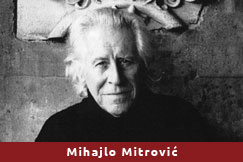 criterion was the establishment of a
causal link between ethical and
aesthetic values, on the one side,
and the freedom of man, on the other
side, as contrasted to something
that was called an “intertia of
clerical mentality” by Mihajlo
Mitrović, one of the protagonists of
Serbian and Yugoslav architecture.
By cultivating a specific discourse
of mediation between aesthetics and
politics, which basically repeated
the pattern in which Yugoslavia’s
overall politics and culture
functioned at that time, this
prolific architect was just one of
the many fighters for creativity
freedom and non-orthodox modernist
architecture having an exceptional
ideological resonance in their own
historical context. criterion was the establishment of a
causal link between ethical and
aesthetic values, on the one side,
and the freedom of man, on the other
side, as contrasted to something
that was called an “intertia of
clerical mentality” by Mihajlo
Mitrović, one of the protagonists of
Serbian and Yugoslav architecture.
By cultivating a specific discourse
of mediation between aesthetics and
politics, which basically repeated
the pattern in which Yugoslavia’s
overall politics and culture
functioned at that time, this
prolific architect was just one of
the many fighters for creativity
freedom and non-orthodox modernist
architecture having an exceptional
ideological resonance in their own
historical context.
Thus, in
Yugoslavia’s public space modernist
architecture was assigned to
materialize the hardly attainable
goal of freedom, autonomy and
shifting away from canonical
thinking and acting, lying at the
core of the idea about Yugoslavia’s
“socialist democracy”. Over time,
despite all stylistic, morphological
and structural differences relying
on the global trend of redefining
the “international language” of
modern architecture, Yugoslav
architecture of so-called high
modernism in the 1960s and 1970s
became the signifier of the
desirable social values and
constituent part of political
discourse. It participated in a
general revolt against
depersonalization, impersonalness
and standardization – at the same
time when the leadership of
Yugoslavia, “one of the most open
countries” — as once emphasized by
historian Branko Petranović —
promoted the same messages in public
discourse, thus reaffirming the
highest values of a self-management
socialist society. In that sense,
antidogmatism became both the poetic
quality of architecture and contents
of a political ideology. On the
other hand, subjectivism in
architecture was crucial for the
legitimization of the political
course of socialist Yugoslavia and
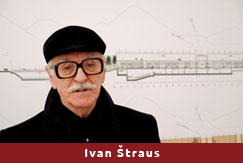 important factor in the cultivation
of diversity (national, ethnic,
cultural, regional), as the
sacrosanct value of Yugoslav
socialism. In socialist Yugoslavia,
as noted by architect Ivan Štraus in
1991, at the time when the rigor
mortis of the state of the “Yugoslav
peoples and nationalities” already
occurred, architecture began to be
viewed in new ways, in accordance
with increasing democratic freedoms,
while at the same time clearly
highlighting individual views. important factor in the cultivation
of diversity (national, ethnic,
cultural, regional), as the
sacrosanct value of Yugoslav
socialism. In socialist Yugoslavia,
as noted by architect Ivan Štraus in
1991, at the time when the rigor
mortis of the state of the “Yugoslav
peoples and nationalities” already
occurred, architecture began to be
viewed in new ways, in accordance
with increasing democratic freedoms,
while at the same time clearly
highlighting individual views.
This testifies
that mere utilitarianism in
architectural poetics was
transcended by the construction of
an aestheticized world as the
projection of the origin of the
movement of the entire society. In a
subtle ideological shift from
functional to nonutilitarian,
architecture was a striking example
of transitoriness, changeability and
mobility, as the central social
values. Despite the functional
requirements on which it was based,
its emergence as an aesthetic
phenomenon understandably had both
ethical and political dimensions.
From that perspective, the
architecture of modernism
represented quite an autonomous
value system in accordance with the
basic ideas of modern art, but its
relationship with the social context
was by no means excluded. On the
contrary, the idea of autonomous
architecture with individualism at
its root as the most important
characteristic of something named
“socialist aestheticism” first in
the criticism of Yugoslav culture
and then in historiography, was part
of the process of spatializing the
ideological premises of socialist
self-management: free society,
plurality of thought and action, and
insistence on cultural diversity.
***
If the historical
experience of Yugoslav modernism is
viewed in its historical context,
outside the tradition of great
architectural narratives, and if it
is critically evaluated relative to
the idea about the autonomy of
modern art, it testifies not only
that architecture cannot be
considered value-neutral, but that
we must also understand it as a
basically ideological practice.
Namely, the historicization of the
architecture of modernism in the
first and second Yugoslavia can
confirm not only the general
theoretical premises of culture as
an ideological system in which
cultural forms and processes obtain
politically instrumental meanings,
but also much more than that. It
seems that a new reading of all that
was written and thought about the
architecture of modernism by its
contemporaries, including its own
ideological horizon trends, as well
as a careful interpretation of the
form of its presence in public
space, can help us open the new
views on the whole Yugoslav past. In
that landscape, the contours of the
architecture of modernism in
Yugoslavia will also be clearer and
less obscured by double resistance,
which still hinders its
consideration — resistence from the
discipline of architectural history,
including its obsession with
stylistic, formal and theoretical
genealogies and typologies, and its
unwillingness to offer a rational
interpretation of the Yugoslav
experience. A new image can help
that Yugoslav architecture is
understood not as a phenomenon
separated from its historical
context, or just a form of
legitimation of political ideas and
regimes, but as the constituent part
of the world of ideas on which the
diverse ideological foundations of
the Kingdom of Yugoslavia and its
socialist successor state were laid.
|